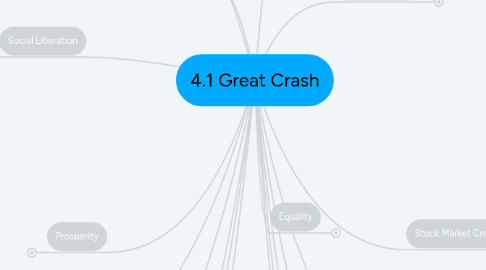
1. Prohibition
1.1. banned the sale of alcoholic beverages
1.2. 21st amendment repealed prohibition
1.3. The Temperance Movement
1.3.1. established in 1826
1.3.2. 170,000 members took a pledge to abstain from drinking distilled beverages
2. Cultural Changes
2.1. Half of the population started to move and enjoy the urban life
2.2. Woman found low paying jobs in cities, office typing, and nursing.
2.3. Birth Control Movement
2.3.1. Concerned with woman's rights and sexual freedom
2.3.2. Different techniques including rhythm method, withdrawal, etc.
3. Immigration
3.1. Immigration Act of 1924
3.1.1. established immigration for each nationality
3.1.2. The act replaced a system
3.1.3. Asians previously that were allowed to immigrate can't immigrate no anymore
3.2. Movement of people into a country or destination
4. The Economy
4.1. 1920, economy grew 42%
4.2. Mass production spread new goods in households
4.3. World War I destroyed most of Europe
4.3.1. Construction doubled from 6.7 billion to 10.1 billion
4.3.2. Unemployment rose to 11.7 percent
4.3.3. Average income rose $2000
5. Social Liberation
5.1. Women Liberation
5.1.1. Played a huge role in woman's rights and equality
5.1.2. By the 20th century, the role of women in America were changing
5.1.3. Women working more, receiving better education, fewer kids
5.2. 19th Amendment
5.2.1. Women were allowed the right to vote. Not only women but anyone
5.2.2. Women practiced civil obedience
5.3. Flappers
5.3.1. A style that women used to express greater independence
5.3.2. Wore short skirts, bobbed hair, and listened to jazz
5.3.3. Women were much more independent
6. Equality
6.1. American economy growth rate was led by the automobile industry
6.1.1. # of cars on the road tripled between 1920 and 1929
6.2. "Jazz age" and the "Roaring Twenties"
6.2.1. Jazz age was when styles of music and dancing was emerged
6.2.1.1. African Americans enjoyed musical techniques
6.2.2. Roaring twenties created an era of mass consumerism
7. Prosperity
7.1. Consumption
7.1.1. Made it possible for ordinary Americans to purchase goods
7.1.1.1. Radios, cars, vacuums, beauty products, and clothing
7.1.2. Expansion of credit allowed the sell for goods and automobiles
7.1.3. Individuals who couldn't afford a car could pay for it overtime with interest
7.2. Success from having a lot of money
7.3. Latin word means fortunate
8. Stock Market Crash
8.1. Farm Labor
8.1.1. Poorest workers in the country
8.1.2. Agricultural work
8.1.3. 2 million farm workers labor in the fields and other ranches across the U.S.
9. Unemployment
9.1. Causes
9.1.1. Black Thursday
9.1.2. Official start of the Great Depression
9.1.3. Stock prices dropped
9.1.4. Market crash caused a decline in consumer spending and investment
9.1.5. `No financial safety
10. Fall in Prices
10.1. Unemployment rose 25%
10.2. Housing prices went up 30%
10.3. 25 years for stock market to recover
11. Production figures
11.1. employment reached double digits in 1930
11.2. Continued through 1932 and 1933
11.3. Workers were unable to find jobs
12. Mass migration
12.1. Take an important role on how americans talk about the history of poverty and public policy
12.2. Migration of large groups from on area to another
12.3. The movement of people to the united states started around 1600
13. Crime Rates
13.1. Criminal activities like bootlegging, robbing banks and murders
13.2. 18th Amendment
13.2.1. Fueled the rise of the organization crime

